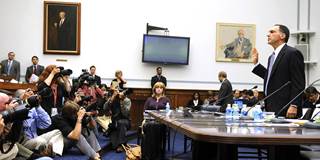A serious legislative effort, supported by the Trump administration, is underway to reduce the level of scrutiny applied to banks that are on the verge of becoming systemically important. If congressional Republicans have their way, financial stability will be at greater risk than at any time since the 2008 crisis.
WASHINGTON, DC – Last week, with some fanfare, the US Treasury Department released a report on what to do about the Orderly Liquidation Authority. The OLA, created under the Dodd-Frank financial reform legislation of 2010, was intended to prevent a recurrence of what happened in September 2008, when one failing firm, Lehman Brothers, was able to trigger a cascade effect that nearly destroyed the financial system.

WASHINGTON, DC – Last week, with some fanfare, the US Treasury Department released a report on what to do about the Orderly Liquidation Authority. The OLA, created under the Dodd-Frank financial reform legislation of 2010, was intended to prevent a recurrence of what happened in September 2008, when one failing firm, Lehman Brothers, was able to trigger a cascade effect that nearly destroyed the financial system.